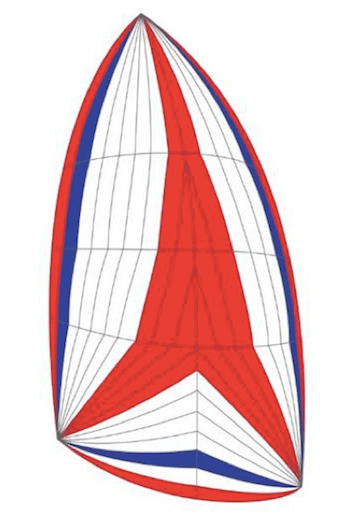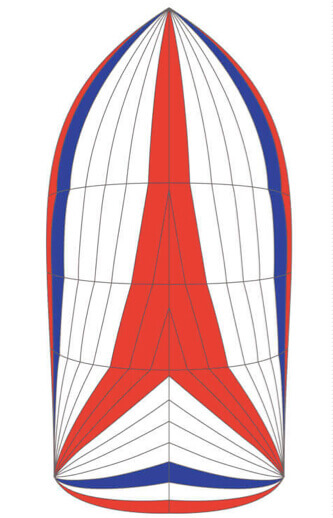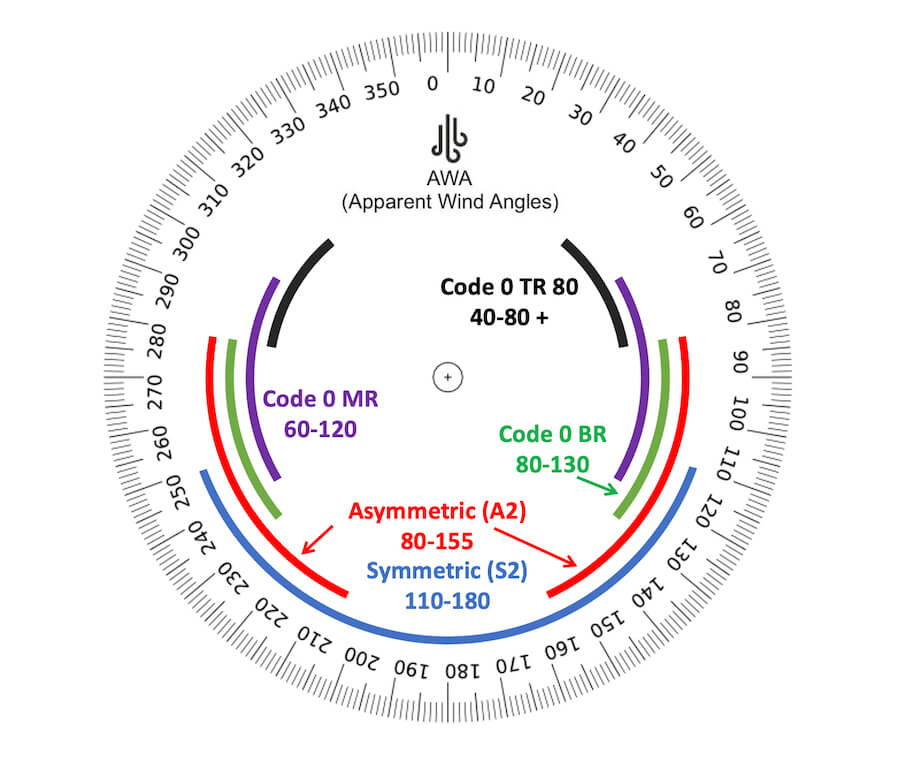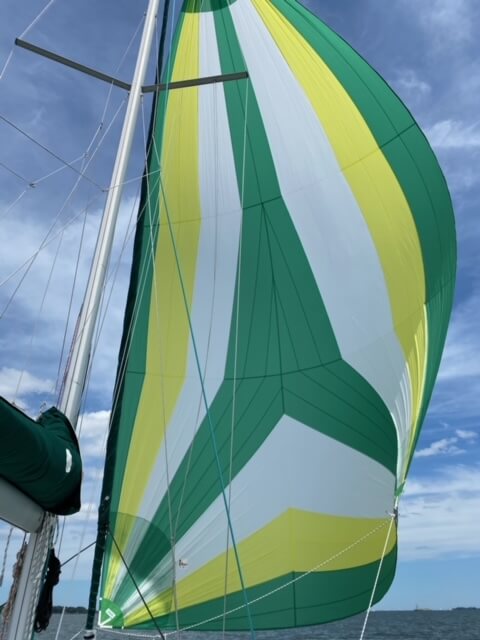
- Symmetrical or asymmetrical?
- Spinnaker sizing dilemma
- Standard or custom cut?
- Colors and logo?
- Equipement you need to fly a spinnaker
- Sock or furler
- Contact us for advice

1. SYMMETRICAL OR ASYMMETRICAL SPINNAKER?
Asymmetrical spinnakers are generally our most popular sails, but here are a few points to consider to help you in your selection.
What is your most frequent crew situation?
- A symmetrical spinnaker is more complicated to launch, gybe and retrieve – and requires a bowman when gybing. If your crew is numerous, agile and likes action, a symmetric may be more fun to use.
- On the other hand, if you sail short handed, or even solo, or with a crew that enjoys the peace of sailing more than the intense activity that can occur on a rolling foredeck when gybing a symmetrical, then an asymmetrical spinnaker might be for you.
Do you want or need to run deep down wind?
- If you need to run deep down wind, then a symmetrical spinnaker is absolutely the way to go as the pole will let you set the spinnaker away from the main sail wind shadow; this might be necessary if you use the boat for racing and your club favors windward – leeward courses; or if your sailing venue involves a channel that needs to be run dead down wind, etc.
- With an asymmetrical spinnaker you just cannot run dead downwind. You will have to gybe (which is not that complicated with an asymmetrical) and go from broad reach on one tack to broad reach on the other. In a cruising situation this may provide a similar VMG and be more comfortable as it limits the boat rolling that can not be avoided when running with a symmetric spinnaker.




2. THE SPINNAKER SIZING DILEMMA
Many customers ask us which spinnaker size to choose, and this mostly depends on your boat model, and whether your rig / mast has been customized or not; please check our article dedicated to sizing.

3. spinnaker with a standard cut or custom cut for cruising?
Spinnakers are not as finicky as other sails, so chances are standard cut will be right fo you, that said:
- Our standard size spinnakers have a great all around shape, and are designed to be easy to fly with minimal fussing – perfect if you are going to have only one spinnaker.
- Our standard shapes are designed to fit the wide variety of boats out there – While they have a great all around shape and will fly beautifully regardless of what boat you sail, this can result in some minimal compromise in sail size versus the maximum sail size your boat could handle.
- Additionally, since our spinnakers use set sizes, you might have to go for the smaller size if your boat falls in between two sizes. Maximizing spinnaker size may just not be important for you: many of our clients are happy with a slightly smaller spinnaker – because they sail in a very windy venue anyway; or because they do not have a very agile crew, etc.
- A custom-cut spinnaker will almost always be a little bigger than a standard size one, which might be a plus if you often sail in low wind conditions, or your program includes racing the boat.
- A custom-cut spinnaker will be designed for any special situation you have: for example, if you already own a very deep, round running symmetric spinnaker, you might want a flatter spinnaker for going on tight reaches. Or perhaps you sail on a lake: even if you are going to have a single spinnaker – you might want a spinnaker that is focused on very light air: bigger size, lighter cloth, etc. Let us know your constrains and we will work with you on the right custom-cut spinnaker.
- There are many cases that may call for a fully custom sail – if you think you need one just contact us.

4. can a spinnaker have my colors or a logo?
Yes, and it is quite easy. We offer the possibility to build your own custom color spinnaker, choose among 13 colors, and select a color for each panel to build you theme. Add a logo, for example for name of your boat. More details here.

5. SOCK OR FURLER?
A sock makes launching and retrieving the spinnaker much easier, as it allows to fly the sail only when fully hoisted and ready; and “snuff ”it before taking it down. This is specially important with a symmetric spinnaker and/or a less “maneuver-ready” crew.
Find more about socks here


6. does a spinnaker require extra equipment?
Well, it depends if you want an asymmetric or a symmetric spinnaker.
- For a symmetrical spinnaker, you will need at minimum a spinnaker pole, a ring on the front of the mast, preferably track mounted, a topping lift and attendant hardware, and a down haul.
- For an asymmetrical spinnaker, you will need at minimum a tack attachment point on deck set in front of the mainstay; and a tack line that will let you adjust the height of the tack according to conditions and apparent wind angle. This tack line should preferably run back to a winch in the cockpit for easily adjusting the luff curve the sail under way.
. - For both types of spinnaker, you will also need:
- A spinnaker halyard, (i.e. halyard which top block is set above the headstay).
- A set of blocks at the back of the boat on either side that allow running the sheet / guy to a free winch.
- A set of sheets.

